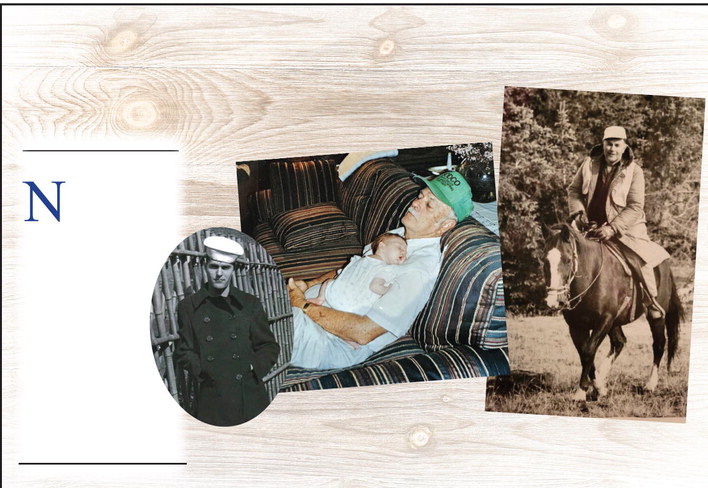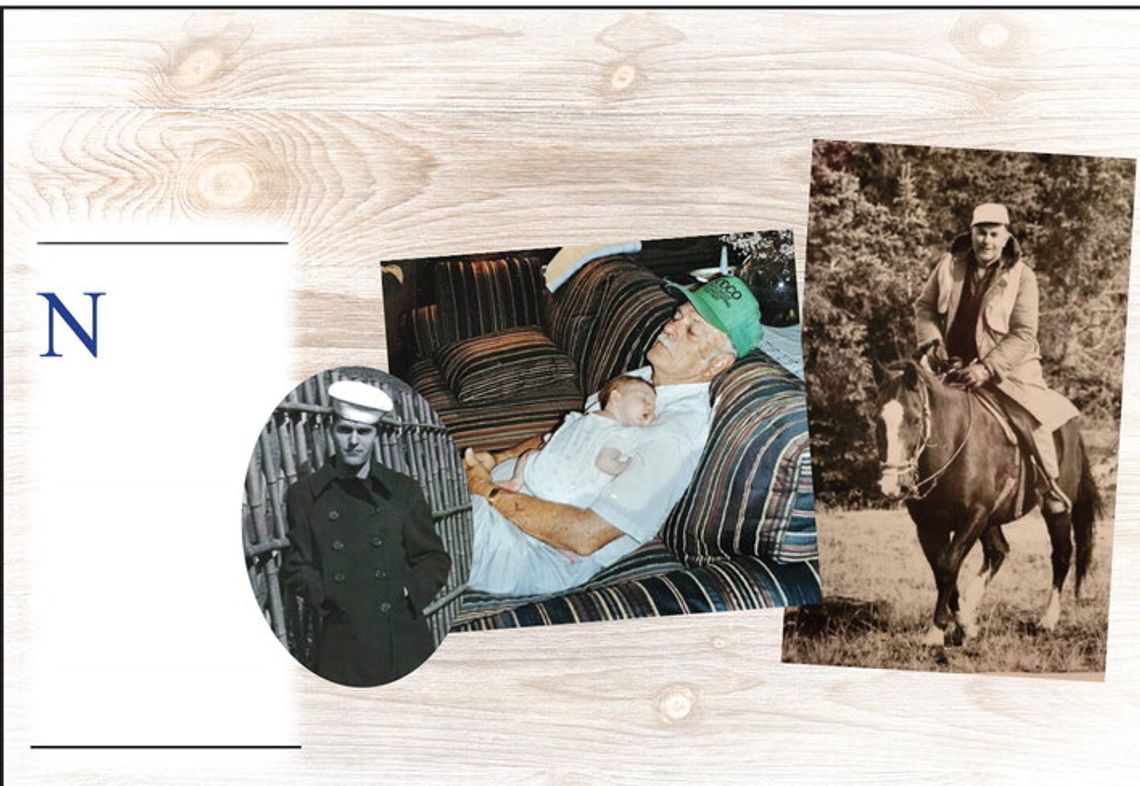Davis recalls days in Navy ahead of 100th birthday
early 80 years ago, Ed Davis was manning a 5-inch 38-caliber gun aimed at Kamikazes off the coast of Okinawa, Japan. Now, Davis is just six days shy of marking his 100th birthday, two weeks prior to Veterans Day.
Davis, born Oct. 28, 1923, still lives in his home in the Cibolo Oaks subdivision, with a view of Cibolo Creek from the three-story home backing up to the creek. He’s a soft-spoken, deliberate gentleman
who still gets around with the aid of his walker and enjoys telling of his past, the personal years as well as his military experience.
His deployment began in 1944. “I was late to the war,” he said, allowed to stay home to care for his father, who was nearly blind by cataracts that rendered him unable to tend the farm.

Left: Ed Davis in uniform in in the early 1950s in Yokohama during the Korean War. Courtesy photo Center: “Grandpa” Ed Davis is captured taking a nap with one of his grandchildren sound asleep on his chest. Right: Ed Davis sits tall in the saddle during an elk hunting trip to Colorado.
Courtesy photos “My dad was a farmer, as were most people in those days,” he said. He was a sharecropper until the Depression, when he lost his living-and-working arrangement. He took odd jobs until he’d saved enough to buy a farm “until he got the cataracts and couldn’t see,” he said.
But in 1944, Davis, then a Gatesville, Texas, resident, got the call – Uncle Sam wanted him.
He reported to the Farragut Naval Training Station in Idaho, near Coeur d’Alene.
“I had an opportunity to go into the Navy or the Army,” he said. “I had never seen the ocean, so I chose the Navy.”
He entered the ranks of the Navy in spring of 1944, with boot camp and naval training taking up most of the rest of the year.
But when he “shipped out,” he was placed aboard a destroyer, the U.S.S. McDermut.
“The McDermut went to Okinawa. We were there for most of that operation,” he said.
The Battle of Okinawa was the bloodiest battle in the Pacific – referred to as the “typhoon of steel” for the numbers of Allied ships and the number of Japanese kamikaze pilots used against Allied forces.
Davis was assigned to a 5-inch 38-caliber gun. “Most of our action out there was kamikazes, keeping them away from the carriers. We had more warships damaged and sunk up there than in the rest of the war.”
More than 1,900 kamikaze attacks occurred during the 82 days of battle.
“We had five 5-inch guns. There were three men in the turret, and five guys that were getting ammunition into the (hoist) that sent the shell up to the guns,” he said.
He said there were a number of 40-millimeter and 20-millimeter guns aboard the McDermut.
“If you heard the 20-inch guns firing, you knew a plane was close,” he said.
“After that operation was finished, we went up and down the coast of Japan, doing air strikes to protect the carriers,” he said. “We’d do bombardments and pick up pilots that went into the drink.”
Davis was aboard the McDermut through the end of the war. He arrived stateside in the fall of 1945 before being called back into the military for a 19501952 tour of duty in the Korean War.
In the meantime, Davis started a family. He married wife Virginia in 1948 while attending the University of Texas in Austin. The first of their five children was born in 1949; Virginia and the family stayed with her parents while Ed was off serving in Korea.
After returning from Korea in 1952, he earned an architectural design degree from UT and eventually became a general contractor, a career that took him into the late 1980s.
“Life is like a series of picture postcards, with some great distance between them,” he said.
He remembers the first TV set they ever purchased; he remembers the first time seeing a computer, that a neighbor had purchased. He recalls where he was when man first landed on the moon, and remembers standing out in front of his office when news broke that President John F. Kennedy was shot.
“In some ways, my whole life has been driven by when I was born,” he said, referring to the years leading up to the Great Depression. “It was in the Depression. We were poor; I never had any money in my pocket until I got out of high school.”
Davis's construction career took him to build the first cellphone tower in San Antonio for Southwestern Bell, as well as a number of jobs at Hemisfair in 1968. But Davis said he had to give credit where credit is due, for his successes and long life.
“When you get to a turning point in life, getting married, starting jobs, making a living – I could have been killed, but I wasn’t,” he said, a reference to serving during two different military campaigns. “In construction you’re always one job away from being bankrupt.
“These are things I look back on, and see that God was taking care of me,” he said. “There were numerous times when something had happened, and I was saved; that’s what it had to be.”









Comment
Comments